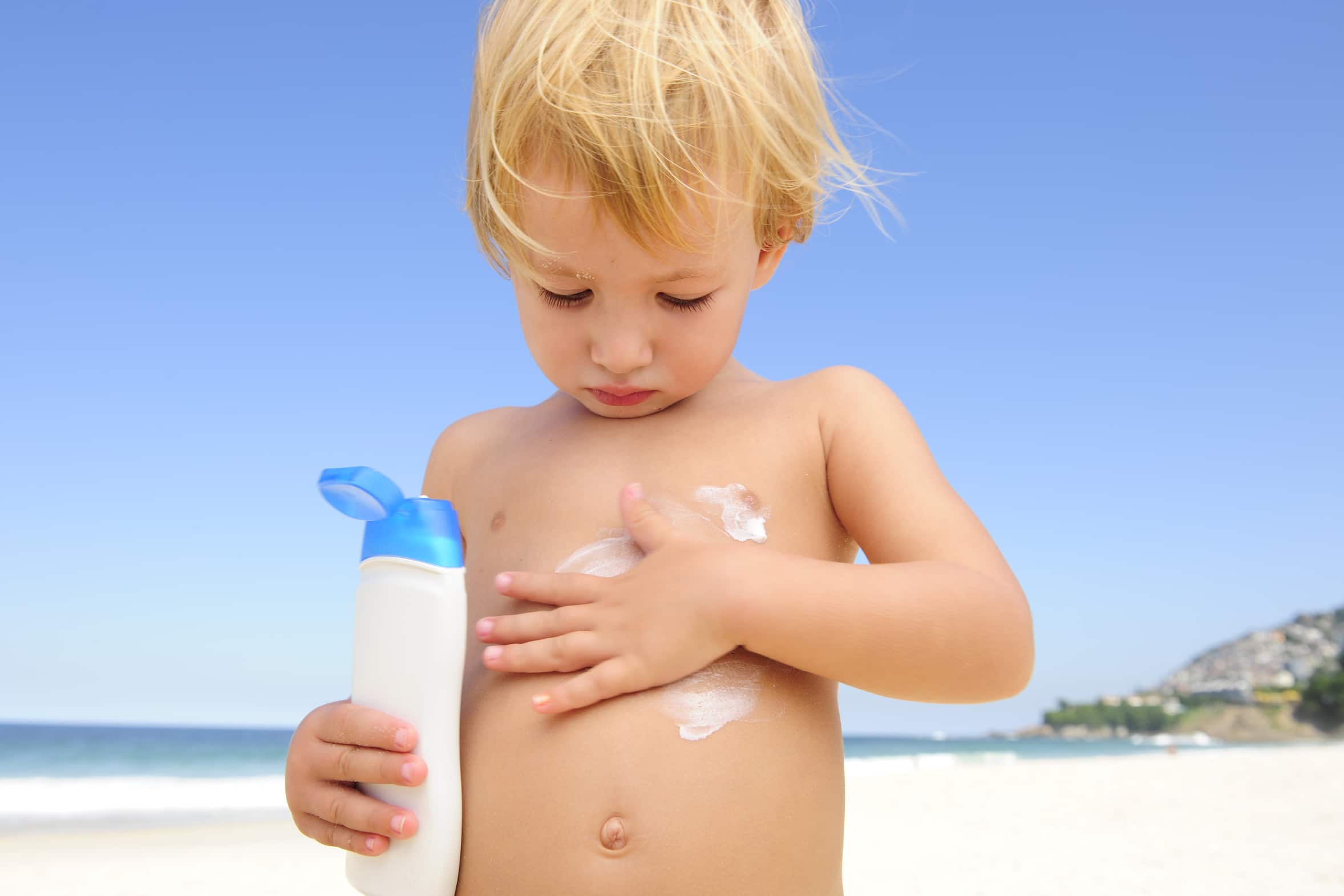Children’s sun protection

Children’s skin is highly sensitive to the sun.
Children’s sun protection is very important, their skin has not yet developed any natural protection, such as light calluses, pigmentation, urocanic acid in sweat and repair mechanisms. And even these provide only limited protection and are unable to prevent the ageing, cancer-promoting effects of the sun.
In addition to treating the sun with respect, protection from it is also important.
But, which UV filters are suitable, especially for children’s sun protection?
Time and again we read about filters that may cause cancer and allergies.
Critical UV filters and suitable children’s sun protection are a sensitive issue. Children’s sun protection products must particularly fulfil the requirements that apply to every cosmetic sun protection product.
They must protect against UVB and UVA rays; the UVA protection must be one third of the UVB factor. In most cases, several filters are combined in one product to achieve broad-spectrum protection.
The UV filter must not decompose under UV rays, i.e. it must be photostable and provide the advertised performance for hours. It must not trigger allergies or have negative side effects, e.g. hormonal effects.
Children’s sun protection can also be provided with good sun protection creams for the whole family. But what are good sun protection products? It helps to look at the ingredients. This is easier in the USA, by the way, as the sun protection filters are listed separately.
Firstly, a general distinction between sun protection filters.
Mineral filters
Mineral or physical filters are titanium dioxide and zinc oxide.
They form a barrier on the surface of the skin that reflects all rays.
They do not break down, do not cause allergies and are therefore widely used in children’s sun protection.
Their disadvantage is that they have a white colour and are difficult to spread and remove from the skin.
With the smallest particles, nanoparticles, they are easier to spread.
This is where the criticism comes in: Nanoparticles can enter the bloodstream and are a particular concern in children’s sun protection.
Nano-sized particles must be labelled on the product, with the word “nano” in brackets after the filter.
According to the EU definition, nanoparticles are particles with a size of 1- 100 nanometres.
The EU recommends labelling as “nano” if more than half of the white particles are in this size range.
The labels regulate the handling of nanoparticles differently.
While Natrue allows nanoparticles, Cosmos (BDHI and Ecocert) prohibits them.
Certified natural cosmetics only use mineral filters.
They are used in many products for sensitive skin and children’s sun protection.
Their use can reduce the proportion of chemical filters in a formulation.
Chemical filters
They spread well, are easy to remove and – unlike mineral filters – do not accumulate in the stratum corneum and do not dry out the skin.
They penetrate into the deeper layers of the skin, absorb the high-energy UV radiation and convert it into harmless heat radiation.
Penetration into the skin poses potential problems, as this can lead to absorption into the body.
The filter substances can enter the bloodstream and have already been detected in blood and breast milk.
For some chemical filters, there are indications of hormone-like effects from laboratory tests.
In addition, some are suspected to be carcinogenic and harmful to corals.
The last point of criticism relates to water resistance. A product is considered waterproof if at least 50 per cent of the product remains on the skin after 20 minutes in water. Substances are released into the water.
There are now a number of modern chemical filters that are compatible and offer advantages.
On the other hand, there are chemical filters that are used relatively frequently, although they are criticised for their side effects and are being re-evaluated by the EU.
Natural light protection filters
Natural substances (e.g. shea butter, bisabolol, sunflower, sesame or rice germ oil or vitamin C, green tea) also have a filtering effect, but the protective effect is too low to be a real alternative.
UV filters in detail
HOMOSALATE
Homomenthyl salicate (homosalate) mainly absorbs UVB rays, is photostable and is used in sun creams up to 10%.
It is suspected of acting as an endocrine disruptor in humans and aquatic fauna. It is being analysed by the EU’s Scientific Committee on Consumer Safety (SCCS).
The World Health Organisation (WHO) has not yet confirmed the suspicion.
Homosalate can trigger allergies.
ETHYLHEXYLMETHOXY CINNAMATE
The derivative of cinnamic acid, also known as octinoxate, protects against UVB rays and helps to protect the skin against skin cancer. Its use up to 20% is permitted.
It is suspected of acting like a hormone and is being investigated by the EU Commission.
The WHO has not yet confirmed the suspicion.
It is also said to be partly responsible for coral bleaching and is therefore banned in Hawaii.
Ethylhexyl methoxycinnamate can trigger allergies.
OCTOCRYLENE
It primarily protects against UVB rays and sun damage and helps protect against skin cancer. Octocrylene is photostable and enables the use of avobenzone, which protects against long-wave UV rays. It is also important for water resistance.
However, it is suspected of acting as an endocrine disruptor, having a negative effect on corals and being poorly biodegradable.
Prolonged exposure to the sun can lead to allergies.
However, the SCCS does not classify octocrylene as an allergen and does not consider it to be endocrine disruptive at the maximum permitted levels; the WHO has also not yet confirmed its effect as an endocrine disruptor.
Octocrylene is considered harmful to corals and is banned in Hawaii and the South Pacific region of Palau.
Octocrylene decomposes into harmful substances over time. Products containing octocrylene should therefore not be stored for long periods of time.
French researchers have found that products containing octocrylene as a sunscreen form benzophenone over time, which is suspected of causing cancer.
The SCCS speaks of a “dangerous contamination” with benzophenone in products containing octocrylene.
The BfR does not expect any health effects, but a “general recommendation is not possible”.
BENZOPHENONE
The substance declared as benzophenone in the list of ingredients protects against UVB and short-wave UVA rays. It is photostable. However, it has an unfavourable environmental profile and is suspected of contributing to coral bleaching and acting as an endocrine disruptor. While the WHO denies endocrine disruption, benzophenone is therefore being re-evaluated by the SCCS.
Benzophenone is considered allergenic.
Benzophenone is banned in Hawaii due to its coral-damaging effect.
TITANIUM DIOXIDE
The mineral made of titanium and oxygen, listed as titanium dioxide in the list of ingredients, protects against UVB and UVA rays.
It was criticised in a study by the International Agency for Research and Cancer, according to which it was classified as carcinogenic when ingested orally.
The same applies to inhalation when titanium dioxide is finely atomised in the spray.
The SCCS has therefore re-evaluated titanium dioxide and categorised it as carcinogenic when inhaled and has therefore banned it in sun sprays.
It is unproblematic in creams, even in nano-size, and is authorised in a concentration of 25%.
According to the Federal Institute for Risk Assessment (BfR), it cannot enter the body in creams. The nanoparticles are 10-100 times larger than the smallest particles in chemical filters.
Nevertheless, Cosmacon has decided NOT to use this physical UV filter any longer.
CHEMICAL FILTERS WITH A GOOD PROFILE
They are considered skin-friendly and are photostable:
Bis-Ethylhexyloxyphenol Methoxyphenyl Triazine
Drometizols Trisoloxanes
Terephthalidene Dicamphor Sulforic Acid
Ethylhexyl Triazones
Diethylamino Hydroxybenzoyl Hexyl Benzoate
Diethylhexyl Butamindo Triazone
Phenylbenzimidazole Sulfonic Acid
Phenylene Bis-Diphenyltriazine
Butyl Methoxydibenzoylmethane, also known as avobenzone, has a maximum absorption at 357 nm and is therefore suitable for protection against UVA rays. However, the substance is only photostable in combination with other filters.
ZINCOXIDE
The mineral, listed as Zinc Oxide in the list of ingredients, protects against UVB and UVA rays. It also has anti-inflammatory, soothing, astringent and drying properties.
According to the Food and Drug Administration, it is safe and is one of the few approved sunscreen filters that are generally considered safe and effective.
However, like titanium dioxide, it can accumulate in the stratum corneum, less so in the thicker skin of men than in the thinner skin of women. This leads to water loss and dehydration of the skin. As the skin of babies and children is even more receptive, some people advise against using mineral filters in children’s sun protection.
Conclusion
There are a variety of UV filters – and not all common filters are suitable for children’s sun protection. New studies are producing findings that require new tests and the results of which make modern products safer.
According to current knowledge, mineral filters, especially zinc oxide, appear to be the better choice for children’s sun protection. For babies and toddlers, they should not contain nanoparticles or only as much as is necessary for comfortable use. There are also suitable products for children’s sun protection with chemical filters. It is important to avoid the filters that have been criticized. The best alternative is not to expose small children to the sun and to wear a shirt, hat and glasses.
Cosmacon will be happy to help you choose the right filters for children’s sun protection.
Literature:
[Effects of solar radiation and an update on photoprotection].
Garnacho Saucedo GM, Salido Vallejo R, Moreno Giménez JC.An Pediatr (Engl Ed). 2020 Jun;92(6):377.e1-377.e9.
Diehl K, Thoonen K, Breitbart EW, Pfahlberg AB, Görig T.Int J Environ Res Public Health. 2022 Jun 4;19(11):6876
Sabzevari N, Qiblawi S, Norton SA, Fivenson D.Int J Womens Dermatol. 2021 Jan 23;7(1):28-44
Cutaneous Photoprotection: A Review of the Current Status and Evolving Strategies.
Suozzi K, Turban J, Girardi M.Yale J Biol Med. 2020 Mar 27;93(1):55-67. eCollection 2020 Mar.
The Sunscreen for Kindergarteners (SKIN) Study trial protocol.
Lee GH, Bae GH, Barnes LA, Pol-Rodriguez MM, Ransohoff KJ, Nord KM, Lu Y, Cannell B, Weitlauf JC.Contemp Clin Trials. 2021 Aug;107:106480.
Ultra violet filters in the urine of preschool children and drinking water.
Li N, Ho W, Wu RSS, Tsang EPK, Ying GG, Deng WJ.Environ Int. 2019 Dec;133(Pt B):105246.
